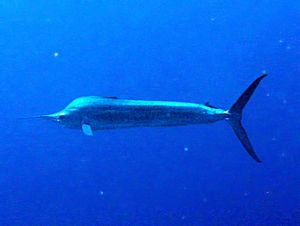Indo-Pacific blue marlin facts for kids
The Indo-Pacific blue marlin (Makaira mazara) is a type of marlin. It belongs to a family of fish called Istiophoridae. These powerful fish are known for their long, pointed upper jaw, which looks like a spear.
Quick facts for kids Indo-Pacific blue marlin |
|
|---|---|
 |
|
| Makaira mazara from French Polynesia | |
| Scientific classification | |
| Genus: |
Makaira
|
| Species: |
mazara
|
| Synonyms | |
|
Eumakaira nigra Hirasaka & Nakamura, 1947
Istiompax howardi Whitley, 1954 Istiompax mazara (Jordan & Snyder, 1901) Makaira ampla subsp. mazara (Jordan & Schneider, 1901) Makaira nigra (Hirasaka & Nakamura, 1947) Makaira nigricans subsp. mazara (Jordan & Snyder, 1901) Tetrapturus mazara Jordan & Snyder, 1901 |
|
Contents
Blue Marlin Family Tree
The Indo-Pacific blue marlin is very similar to the Atlantic blue marlin. Some people even think they are the same species. Scientists are still discussing if they should be classified as two separate species.
Even though they live far apart, some genetic studies show they are very alike. This might be because some Indo-Pacific blue marlins travel to the Atlantic Ocean. They then share their genes with the Atlantic population. Other studies, however, suggest they are distinct groups.
Where Blue Marlins Live
You can find the Indo-Pacific blue marlin in warm waters around the world. They live in the Pacific and Indian Oceans. Warm ocean currents, like the Agulhas Current, help them move around. These currents affect where the marlins are found during different seasons.
They are common in areas near the equator. However, they usually stay away from islands and coral reefs. This type of marlin prefers the warmest parts of the ocean.
What Blue Marlins Look Like
The Indo-Pacific blue marlin can grow very large. They can reach up to 5 metres (16 ft) (about 16 feet) long. The average size is around 3.5 metres (11 ft) (about 11.5 feet). These fish can weigh as much as 625 kilograms (1,378 lb) (about 1,378 pounds).
Their bodies are long but not very flat. They have two dorsal fins on their back and two anal fins on their belly. Their pectoral fins, which are like arms, are flexible. They can fold them close to their body.
The upper jaw forms a strong, round beak. It is not extremely long. The tail area has strong double ridges on each side. The top of their body is blue-black. Their belly is silvery white. Sometimes, they have light blue stripes running down their sides.
Blue Marlin Life and Habits
Indo-Pacific blue marlins lay their eggs during the summer months. This happens in both the Indian and Pacific Oceans. In the southern part of the world, they likely reproduce near French Polynesia.
These marlins are known for traveling long distances. They are highly migratory fish. They use their strong, pointed bill to injure their prey. This helps them catch other fish to eat.

